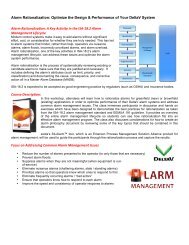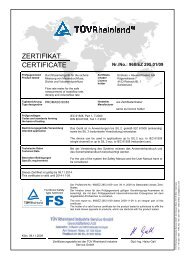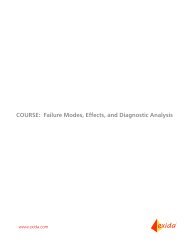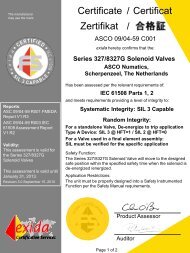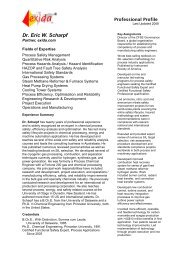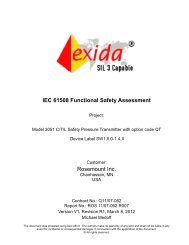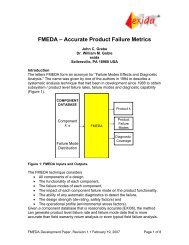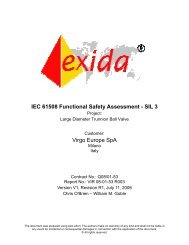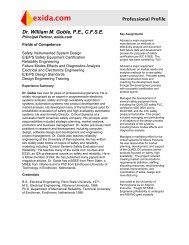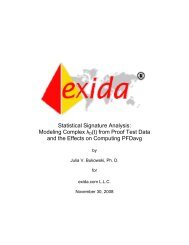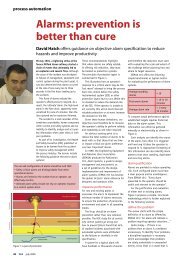Frequently Asked Questions - Exida
Frequently Asked Questions - Exida
Frequently Asked Questions - Exida
Create successful ePaper yourself
Turn your PDF publications into a flip-book with our unique Google optimized e-Paper software.
<strong>Frequently</strong> <strong>Asked</strong> <strong>Questions</strong>The exida 61508 Certification ProgramV1 R9 February 11, 2008exidaGeneva, SwitzerlandSellersville, PA 18960, USA, +1-215-453-1720Munich, Germany, +49 89 4900 0547
1 <strong>Exida</strong> Certification ProgramThe exida IEC 61508 Certification Program was established in 2005 in response to demandprimarily from end users in the process industries and manufacturers of instrumentationproducts. There was a need to provide high quality technical capability with effective andresponsive service.The exida Certification Program is operated by an independent legal entity based in Geneva,Switzerland which is the home of the International Electro-technical Committee (IEC).Assessors from• the exida certification company or• other exida organizationsare assigned on a project basis under management from the exida certification company.Individuals are assigned to do the IEC 61508 assessments such that no one who has workedon a project as a consultant may participate in the assessment. The exida program ensures anindependent audit and assessment.2 <strong>Frequently</strong> <strong>Asked</strong> <strong>Questions</strong>2.1 Who authorizes exida to perform IEC 61508 certification?The IEC 61508 standard requires “evidence of competence” of those who perform assessmentsbut does not require they be formally authorized or accredited. However, most end users whopurchase IEC 61508 certified equipment demand that the certification be done by a highlycompetent technical organization with experience in mechanical design, electronic design,software design and probabilistic analysis. The organization doing the work must demonstratestrong competency in these key areas of functional safety. To our knowledge the onlyaccreditation program in the world specifically oriented toward IEC 61508 is done by the U.K.government via the United Kingdom Accreditation Service (UKAS), www.ukas.com. Thisaccreditation also requires that the EN45011 product certification quality program be met.<strong>Exida</strong> has applied to UKAS for full accreditation to IEC 61508 and EN45011.2.2 Is a Nationally Recognized Testing Laboratory (NRTL) required for IEC61508 certification in the U.S.?One must not confuse electrical safety with functional safety. Electrical safety certification in theU.S. is recognized by OSHA and must be done by a Nationally Recognized Testing Laboratory(NRTL). An NRTL must meet strict requirements for document control and measurementcapability with calibration traceable to the National Institute of Standards and Technology(NIST), www.nist.org.The ability to accurately assess functional safety as required by IEC 61508 is a very differenttechnical field than the ability to accurately measure electrical currents, voltages, temperatures,etc. To certify that a product meets the requirements of IEC 61508, the certification agencymust have full competency in:• Mechanical design: stress conditions, useful life and systematic design procedures• Software design procedures and software failure mechanisms• Electronic hardware design procedures, electronic hardware failure mechanisms© exida, 2007 IEC 61508 Certification Program – <strong>Frequently</strong> <strong>Asked</strong> <strong>Questions</strong>Page 2 of 13
• Hardware Failure Modes, Effects and Diagnostic Analysis (FMEDA)• Hardware probabilistic failure analysis: stress conditions and useful life• Hardware and software testing procedures and methods• Quality procedures, document control and functional safety management2.3 Is a Notified Body required for IEC 61508 certification in the E.U.?A Notified Body in the European Union (E.U.) is similar to a NRTL in the U.S. Notified Bodiesmust also pass strict criteria for measurement and calibration. This is not relevant to IEC 61508nor is Notified Body status required for an organization to issue IEC 61508 certifications as IEC61508 is not listed under a specific European Directive but is a Basic Safety Publicationapplicable to many application areas where no specific functional safety rules exist.2.4 Does exida have personnel competent to perform assessment to IEC61508?The exida 61508 Certification Services team has a combination of over 200 years experience inIEC 61508 assessment and certification. Several of the exida team members are ex-TÜVengineers with decades of functional safety assessment experience. Some team members aremechanical design experts with decades of experience in mechanical design and mechanicalfailure analysis. Some team members are experienced software designers from instrumentationcompanies. These people have experience in the design and failure analysis of systematicsoftware failures. Some team members are probabilistic failure analysis experts with decadesof failure modeling and analysis experience. Members of exida have written the majority of textbooks published worldwide in the area of functional safety.2.5 Has exida participated on the IEC 61508 committee?Several exida team members have been active on the IEC 61508 committee since its inception.These people continue today as the standard progresses through modification. No othercertification agency in the world has been more active in the creation of this standard.2.6 Does exida have project experience in IEC 61508 certification?People who are now exida team members were the same people who started the functionalsafety certification process in the late 1980’s. Several of our team members have over 20 yearsof project experience in functional safety.2.7 How should exida IEC 61508 certification differ from other certificationschemes?The IEC 61508 standard is a large specification with each sub-clause being a requirement. Thestandard states: “To conform to this standard it shall be demonstrated that the requirementshave been satisfied to the required criteria specified and therefore, for each clause or subclause,all the objectives have been met.”In the opinion of exida, this statement requires a “Safety Case” or “Safety Justification” to therequirements of IEC 61508. A simple certificate and certification report stating generalcompliance with a standard does not fulfill the IEC 61508 requirements. A full Safety Case listsall IEC 61508 requirements and provides the arguments and justification as to how each projectmeets the standard. exida does a Safety Case for each certification project.© exida, 2007 IEC 61508 Certification Program – <strong>Frequently</strong> <strong>Asked</strong> <strong>Questions</strong>Page 3 of 13
In addition, the exida Certification program looks at usability of a product from a systemsperspective and evaluates the likelihood of unintended misuse. Although this is not arequirement of IEC 61508, the exida End User Advisory Council has strongly suggested thismust be done.2.8 Is exida part of any TÜV company?No, exida is wholly owned by independent investors, exida partners and employees. <strong>Exida</strong> is anindependent company.2.9 Who are exida Certification Services customers?ABBASCODelta ControlsDetector Electronics CorporationDresserEmerson RosemountEmerson Fisher ControlsEmerson Fisher Rosemount SystemsEmerson BettisEndress+HauserFoxboro Eckardt GmbHKorea Unicom ValvesMaxonMorinParker SkinnerRGSRockwell AutomationVersa Valves, Inc.VEGA Grieshaber KGWestlockYokogawa2.10 How many certifications has exida done?As of January 2008 exida has successfully completed over 46 IEC 61508 product certifications.At the current rate, during 2008 exida will have completed more IEC 61508 certifications forcurrently marketed products than any other organization.An overview of process industry products that have been assessed to any level is available onthe exida web-site. http://www.exida.com/applications/sael/index.asp© exida, 2007 IEC 61508 Certification Program – <strong>Frequently</strong> <strong>Asked</strong> <strong>Questions</strong>Page 4 of 13
2.11 Why does an exida certificate list IEC 61508 Parts 1, 2, and 3? Othercertificates list IEC 61508 Parts 1 through 7.All the requirements from the IEC 61508 standard are contained in Parts 1, 2 and 3. Part 4contains definitions and Parts 5, 6 and 7 contain informative annexes. See Section 3 of thisdocument for more details.3 IEC 61508 OverviewIEC 61508 is an international standard for the “functional safety” of electrical, electronic, andprogrammable electronic equipment. This standard started in the mid 1980s when theInternational Electrotechnical Committee Advisory Committee of Safety (IEC ACOS) set up atask force to consider standardization issues raised by the use of programmable electronicsystems (PES). At that time, many regulatory bodies forbade the use of any software-basedequipment in safety critical applications. Work began within IEC SC65A/Working Group 10 on astandard for PES used in safety-related systems. This group merged with Working Group 9where a standard on software safety was in progress. The combined group treated safety as asystem issue.The total IEC 61508 standard is divided into seven parts.Part 1: General requirements (required for compliance);Part 2: Requirements for electrical/electronic/programmable electronic safety-related systems(required for compliance);Part 3: Software requirements (required for compliance);Part 4: Definitions and abbreviations (supporting information)Part 5: Examples of methods for the determination of safety integrity levels (supportinginformation)Part 6: Guidelines on the application of parts 2 and 3 (supporting information)Part 7: Overview of techniques and measures (supporting information).Parts 1, 3, 4, and 5 were approved in 1998. Parts 2, 6, and 7 were approved in February 2000.The standard focuses attention on risk-based safety-related system design, which should resultin far more cost-effective implementation. The standard also requires the attention to detail thatis vital to any safe system design. Because of these features and the large degree ofinternational acceptance for a single set of documents, many consider the standard to be majoradvance for the technical world.3.1 OBJECTIVES OF THE STANDARDIEC 61508 is a basic safety publication of the International Electrotechnical Commission (IEC).As such, it is an “umbrella” document covering multiple industries and applications. A primaryobjective of the standard is to help individual industries develop supplemental standards,tailored specifically to those industries based on the original 61508 standard. A secondary goalof the standard is to enable the development of E/E/PE safety-related systems where specificapplication sector standards do not already exist.Several such industry specific standards have now been developed with more on the way. IEC61511 has been written for the process industries. IEC 62061 has been written to addressmachinery safety. IEC 61513 has been written for the nuclear industry. EN 50128 has beenwritten to address safety-related software for the railroad industry. All of these standards builddirectly on IEC 61508 and reference it accordingly.© exida, 2007 IEC 61508 Certification Program – <strong>Frequently</strong> <strong>Asked</strong> <strong>Questions</strong>Page 5 of 13
3.2 SCOPE OF THE STANDARDThe IEC 61508 standard covers safety-related systems when one or more of such systemsincorporates mechanical/electrical/electronic/programmable electronic devices. These devicescan include anything from ball valves, solenoid valves, electrical relays and switches through tocomplex Programmable Logic Controllers (PLCs). The standard specifically covers possiblehazards created when failures of the safety functions performed by E/E/PE safety-relatedsystems occur. The overall program to insure that the safety-related E/E/PE system bringsabout a safe state when called upon to do so is defined as “functional safety.”IEC 61508 does not cover safety issues like electric shock, hazardous falls, long-term exposureto a toxic substance, etc.; these issues are covered by other standards. IEC 61508 also doesnot cover low safety E/E/PE systems where a single E/E/PE system is capable of providing thenecessary risk reduction and the required safety integrity of the E/E/PE system is less thansafety integrity level 1, i.e., the E/E/PE system is only available 90 percent of the time or less.3.3 FUNDAMENTAL CONCEPTSThe standard is based on two fundamental concepts: the safety life cycle and safety integritylevels. The safety life cycle is defined as an engineering process that includes all of the stepsnecessary to achieve required functional safety. The safety life cycle from IEC 61508 is shownin Figure 1.1Concept“ANALYSIS”(End User / Consultant)234Overall ScopeDefinitionHazard & RiskAnalysisOverall SafetyRequirements5Safety RequirementsAllocationOverall PlanningOperation &Installation &Validation6 Maintenance 78 CommissioningPlanningPlanningPlanning1213149Safety-relatedsystems :E/E/PESRealisationOverall Installation& CommissioningOverall SafetyValidationOverall Operation &Maintenance16 Decommissioning10Safety-relatedsystems : otherTechnologyRealisation11Overall Modification15& RetrofitExternal RiskReductionFacilitiesRealisationFigure 1: Safety life cycle from IEC 61508.“REALISATION”(Vendor / Contractor /End User)“OPERATION”(End User / Contractor)The basic philosophy behind the safety life cycle is to develop and document a safety plan,execute that plan, document its execution (to show that the plan has been met) and continue tofollow that safety plan through to decommissioning with further appropriate documentationthroughout the life of the system. Changes along the way must similarly follow the pattern ofplanning, execution, validation, and documentation. Although the standard is written in thecontext of a bespoke system, the requirements are applicable to general product design anddevelopment.© exida, 2007 IEC 61508 Certification Program – <strong>Frequently</strong> <strong>Asked</strong> <strong>Questions</strong>Page 6 of 13
Safety integrity levels (SILs) are order of magnitude levels of risk reduction. There are four SILsdefined in IEC 61508. SIL1 has the lowest level of risk reduction. SIL4 has the highest level ofrisk reduction. The SIL table for “demand mode” is shown in Figure 2. The SIL table for thecontinuous mode is shown in Figure 3.Safety IntegrityLevelProbability of failureon demand, average(Low Demand mode ofoperation)Risk ReductionFactorSIL 4SIL 3SIL 2SIL 1>=10 -5 to =10 -4 to =10 -3 to =10 -2 to =10 -9 to =10 -8 to =10 -7 to =10 -6 to
services specifically require compliance with IEC 61508. So although IEC 61508 originated as astandard, its wide acceptance has led to legally required compliance in many cases.3.5 PRODUCT CERTIFICATIONThe purpose of product certification is to create a set of documents that demonstrate to thepurchaser how a product achieves sufficient safety integrity for use in a safety instrumentedfunction. A product certification is only as good as the documentation produced and thepurchaser of such products should review the certification report for the assessmentassumptions, safety justification to the individual clauses of IEC 61508 and the resultingconditions for use of the product and shall comply with the specifications of the product “SafetyManual”..A product assessment done to the requirements of IEC 61508 should include hardwareprobabilistic failure analysis (FMEDA), field failure analysis, quality system evaluation as well asan assessment of all fault avoidance and fault control measures during hardware and softwaredevelopment. The process assessment includes a detail study of the testing, modification, userdocumentation (Safety Manual) and manufacturing processes.Many of the requirements of IEC 61508 focus on the elimination of systematic faults by use ofthe best practice product design methods. In order to demonstrate compliance with allrequirements of IEC 61508, a product creation process must show extensive use of many faultcontrol and fault avoidance procedures. This applies to hardware, both mechanical andelectrical, as well as software.As an example, the software must be specifically designed to tolerate software faults. Themembers of the IEC 61508 committee have defined a set of practices that represent goodsoftware engineering. They must be applied with different levels of rigor as a function of SILrating of the instrumentation product.Full compliance with the requirements of IEC 61508 is seen when a product does not have anysignificant “restrictions” on usage as documented in the product “Safety Manual.” A large safetymanual with a long detailed list of instructions on how to make the product “safe” is a sure signthe manufacturer does not meet requirements unless these restrictions are implemented by theend user.3.6 The Safety Case MethodologyThe Safety Case / Safety Justification methodology provides a systematic and complete way toshow compliance to one or more standards. The methodology was established in industrieswhich deal with functional safety of computerized automation in nuclear and avionics [DEF97,BIS98].For the IEC 61508 standard, all requirements from IEC 61508 were compiled by exida. Thiscompilation was independently audited by TÜV Süd [TUV00]. Each requirement was preciselydocumented along with the reasoning behind the requirement. The safety case methodstructures the requirements (parent / child) and in some cases combines like requirements.“Arguments / Solutions” provide a description of how each requirement is met by listing designarguments, verification activities and test cases relevant to that requirement. For full traceability,each design argument and verification / test activity is linked with evidence documents showingthe results of the work.When a safety case for IEC 61508 compliance of a product is completed it must show allrequirements along with an argument for each requirement as to how the product meets therequirement. A link to the evidence document that supports the argument is also provided.Additional fields are provided for the independent assessor to record the results of the© exida, 2007 IEC 61508 Certification Program – <strong>Frequently</strong> <strong>Asked</strong> <strong>Questions</strong>Page 8 of 13
assessment and to communicate their expectations with other assessors and the certifyingpersons.Overall, the safety case concept provides a single place to store compliance information in anorganized manner. The use of a safety case provides a systematic means to ensurecompleteness of any assessment. The Safety Case method supports company learning overmultiple projects by establishing a knowledge base consisting of patterns of fundamentalrequirements and related design arguments. Templates and previous examples of evidencedocuments provide the ability to reduce effort on subsequent projects.Note: The term “Safety Case” is being used beyond its original definition [DEF97] in the contextof product certification to IEC 61508 and is based on concepts presented and developed earlier[BIS98].3.7 The exida Open Certification Assessment ProcessManufacturers of safety-related systems / products to be certified and users of such systems /products can get access to the detailed assessment procedures and can buy the supportingsafety case and verification tools. This is to provide openness and ensure implementation of thesafety requirements by the safety-related system / product.The manufacturer of safety-related systems / products to be certified can choose between:o A Functional Safety Management Certificate;o A Type Approval Certificate;o A Product Certificate.The Functional Safety Management Certificate confirms only the compliance of the presentedFunctional Safety Management System and therefore does not allow for the marking ofproducts with the exida Certification mark but does allow the exida Certificate to be shown ongeneral company documentation.The Type Approval Certificate confirms only the compliance of the presented type or prototypeand therefore does not allow for the marking of the products with the exida Certification markbut does allow the exida Certificate to be shown on the product documentation, e.g. SafetyManual.The Product Certificate confirms the compliance of the product as produced and thereforerequires in addition to Type Approval certification, that the product manufacturer’s qualityassurance system is certified. Product Certification also requires surveillance of the productionof the certified product in contrast to Type Approval Certification, allows the marking of theproducts with the exida Certification mark.A typical assessment (Figure 4) begins with a complete review of the written safetymanagement system (SMS) / Functional Safety Management (FSM) plan. This should be adocument or set of documents that describe the process by which a new product is to bedeveloped and modified. The information contained should include all design steps (inputsrequired, processes to be performed and outputs required), all verification activities,responsibilities and all project documentation generated.© exida, 2007 IEC 61508 Certification Program – <strong>Frequently</strong> <strong>Asked</strong> <strong>Questions</strong>Page 9 of 13
Product requirements and design documents are reviewed next. The documents suppliedshould match those required in the functional safety management plan. Evidence that therequired verification activities have been done shall be included. Competency records must bein place and show that those assigned to the project were competent to perform their specifictasks. When the paper review is complete, the assessment continues with detailed on-sitemeetings.Review SMS ProceduresReview Product DesignDocumentationOn-site Meetings:Procedures Used?Actual DocumentsCreated?Validation TestingCreate Safety CaseProblems?Audit CertificationDocumentationCertification report andCertificateFigure 4: exida Open Certification assessment processWhen all relevant documents are reviewed, interviews with the responsible personnel must takeplace. This is done by visiting the development and manufacturing control site(s). One of thekey interview questions is “What process was followed in the design of this project?” and “Havethe safety requirements been implemented the product”. It is surprising how often the answervaries from the process described in the functional safety management plan or from thedocumented safety concept. Any discrepancies must be justified and documented bymodifications to the “project specific functional safety management plan” and safety concept.The site visit must also include witnessed validation testing often including specific fault injectiontests.If all documentation for both the process and the product are complete and seem fit, a safetycase document is created. This step provides a systematic method to ensure that norequirements of the standard(s) are missed. Often missing requirements are identified and theassessment must return to a previous step to correct the problem. When the safety case isjudged to be accurate and complete, the certification report describing all assessment activitiesand their results is written. The documentation is given to an independent auditor to verify.© exida, 2007 IEC 61508 Certification Program – <strong>Frequently</strong> <strong>Asked</strong> <strong>Questions</strong>Page 10 of 13
When the audit is complete and the independent auditor supports the certification, the certificate(Figure 6) is issued.Figure 6: exida IEC 61508 Certificate3.8 The exida Assessment and Certification ReportThe exida Assessment and Certification Report shall give the user of the product detailedinformation to support his confidence in the product and its certification and shall support hissafety-related application of the product. The exida Assessment and Certification Report isstructured as follows:Management summary1 Purpose and Scope2 Description of the product / system3 Project management3.1 Assessment of the development process3.2 Assessment of the technical safety properties of the product3.3 Roles of the parties involved4 Results of the Functional Safety Assessment4.1 Technical safety aspects of the product / system4.1.1 Safety Functions of the product / system
4.2.4 Training and competence recording4.2.5 Configuration Management4.2.6 Tools (and languages)4.3 Safety Requirement Specification4.3.1 Safety Requirement Specification and traceability into design4.4 Change and modification management4.4.1 Change and modification procedure4.5 Hardware Design4.5.1 Hardware architecture design4.5.2 Hardware Design, FMEDA and Probabilistic properties4.6 Software Design4.6.1 Software architecture design4.6.2 Software Design methods, design analysis and static code analysis4.7 Verification4.7.1 SW related Verification activities4.7.1 HW related Verification activities4.8 Validation4.8.1 HW related Validation activities4.9 Safety Manual4.9.1 Operation, installation and maintenance requirements5 Reference documents6 Status of the document6.1 Releases of the document4 REFERENCES[DEF97] Defence Standard 00 – 55, Parts 1 and 2, Issue 2, August 1997, U.K. Ministry of Defence.[BIS98] Peter G. Bishop and Robin E. Bloomfield, "A Methodology for Safety Case Development", inSafety-Critical Systems Symposium, Birmingham, UK, February 1998.http://citeseer.ist.psu.edu/bishop98methodology.html[TUV00] Requirements Database Review, Report #: eS 70177T, TÜV Product Service Inc., October, 20,2000.[IEC00] IEC 61508, Functional Safety of electrical / electronic / programmable electronic safety-relatedsystems, Geneva: Switzerland, 2000.5 Terms and DefinitionsCOTSFITFMEAFMEDACommercial Off The ShelfFailure In Time (1x10-9 failures per hour)Failure Modes Effects AnalysisFailure Modes, Effects and Diagnostic Analysis© exida, 2007 IEC 61508 Certification Program – <strong>Frequently</strong> <strong>Asked</strong> <strong>Questions</strong>Page 12 of 13
FSMIECNISTSIFSILSISSMSSRSFunctional Safety ManagementInternational Electro-technical CommissionNational Institute of Standards and TechnologySafety Instrumented FunctionSafety Integrity LevelSafety Instrumented System – Implementation of one or more SafetyInstrumented Functions. A SIS is composed of any combination ofsensor(s), logic solver(s), and final element(s).Safety Management SystemSafety Requirements Specification6 Status of the documentReleasesVersion: V1Revision: R8Version History: V1, R8: Edited descriptions, updated numbers, Oct. 19, 2007` V1, R7: Incorporated comments from end users, October 9, 2007V1, R6: Added more customer names, certs, August 20, 2007V1,R5: Updated more certifications, minor editsV1, R4: Updated more certifications June 18, 2007V1, R3: Added more certificationsV1, R2: Released; February 5, 2007V1, R1: Released; February 2, 2007V0, R1: Internal Draft; February 1, 2007Authors: William M. Goble, Rainer FallerReview: V1, R2: William GobleV1, R1: Rainer FallerV0, R1: Iwan van Beurden, Greg SaukFuture EnhancementsAs required.Release SignaturesDr. William M. Goble, Principal Partner© exida, 2007 IEC 61508 Certification Program – <strong>Frequently</strong> <strong>Asked</strong> <strong>Questions</strong>Page 13 of 13



